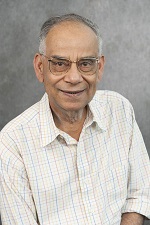Obituary: Ananda M. Chakrabarty

Ananda M. Chakrabarty, Emeritus Distinguished Professor of Microbiology and Immunology, died July 10. He was 82.
Chakrabarty (called called “Al” by his scientific colleagues) was born in the Birbhum district in the Indian state of West Bengal and went to university in Calcutta (now Kolkata).
After completing his Ph.D. in biochemistry at Calcutta University in 1965, he moved to the University of Illinois Urbana-Champaign (UIUC) with his wife, Krishna, who had just completed her biochemistry Ph.D. at the University of California Davis. They stayed at UIUC for six years, during which time Chakrabarty introduced plasmid molecular biology to the lab of Irwin (”Gunny”) Gunsalus, and where he developed his interest in Pseudomonas. He continued laboratory work in Pseudomonas for the next 50 years.
After six productive years in Urbana, Chakrabarty moved to upstate New York, where he introduced plasmid mediated biodegradation work to the General Electric Company, which was making its first move toward bio and environmental microbiology. His early efforts were to use bacteria to convert cow manure to animal feed.
As his favorite side project, he worked in evenings to create Pseudomonas bacteria capable of utilizing fuel oil as nutrient. He moved around Pseudomonas plasmids to facilitate oil pollution cleanup, which was a problem for GE. By 1980, the eight-year-long process to patent the evolved strain of Pseudomonas ended in the U.S. Supreme Court. The then-novel problem of patenting a living cell led to the famous 1980 U.S. Supreme Court decision in the case called “Diamond v. Chakrabarty,” which opened the door for subsequent patenting of recombinant microbes as well as higher organisms.
In June, the Smithsonian Institution in Washington, D.C., hosted a multi-speaker conference on the 40th anniversary of this ruling that began with a brief oral presentation by Chakrabarty. The Chakrabarty patent was of immense importance for the growth of biotechnology companies.
In 1979, Chakrabarty moved to the University of Illinois College of Medicine, and he remained at UIC until retiring in 2018. His large and productive laboratory group of Ph.D. students, postdocs and sabbatical visitors continued work with the molecular biology of plasmid-bearing Pseudomonas capable of metabolizing man-made toxic organic agents. An area of medically important research in Chakrabarty’s lab was the biosynthesis of alginate by the human infectious Pseudomonas.
Chakrabarty’s fame as the name on the first patent for a recombinant microbe led to a second career as an expert and lecturer on legal issues of patenting and intellectual property rights of biological significance. He sat on many American and international committees and taught in workshops for American and international judges on these matters. For his achievements in genetic engineering technology, he was awarded the prestigious civilian Padma Shri by the government of India in 2007. He was for many years a global roving ambassador for UIC.
In recent decades, Chakrabarty’s favorite Pseudomonas cells were the source of small extracellular proteins, especially azurin, as anticancer pharmaceuticals. His work in this area was published in research journals and books, presented in meetings, and developed by start-up companies.
Chakrabarty had more than 60 years as a productive scientist. His contributions have had a major impact on science, policy and generations of trainees and colleagues.
A virtual memorial service is being planned.
